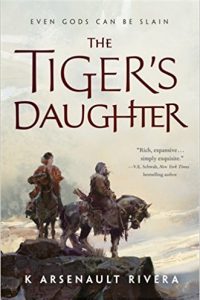The Year’s Top Tales of Space and Time 4 edited by Allan Kaster: Review by Alexandra Pierce
 The Year’s Top Tales of Space and Time 4, Allan Kaster, ed. (Infinivox 978-1-88461-258-9, 276pp, $18.99, tp). Cover by Maurizio Manzieri. September 2024.
The Year’s Top Tales of Space and Time 4, Allan Kaster, ed. (Infinivox 978-1-88461-258-9, 276pp, $18.99, tp). Cover by Maurizio Manzieri. September 2024.
Allan Kaster’s fourth edition of The Year’s Top Tales of Space and Time collects 14 stories, almost all of which originally appeared in familiar periodicals – including Analog Science Fiction and Fact, Asimov’s Science Fiction, Clarkesworld – and one anthology, Life Beyond Us. Some of the authors will also be familiar to Infinivox readers, having appeared in their other anthologies recently (Yoon Ha Lee, A.T. Greenblatt, Aliette de Bodard, Allen M. Steele), while two of the stories are set in existing universes (Paul McAuley’s Quiet War universe, and de Bodard’s Xuya).
As the title suggests, all of the stories collected here involve either time or space as central issues. By my count, four of the stories are a variation on time travel, while one – Greenblatt’s “Waystation City” – covers both time and space. Aside from these obvious similarities, there are some other intriguing themes: one is the recurrence of Mars as a setting, and the other is procreation. These two themes cover some of the best stories in the anthology.
Wole Talabi’s “Blowout” features a drilling team from Earth, on Mars, who experience catastrophe. Set in the (relatively) believable medium-future, Talabi focuses on family relationships as well as the inimical nature of Mars. On the other hand, both Lavie Tidhar and Paul McAuley feature a Mars where humans are managing to live relatively easily, after extensive terraforming, although in both cases there are people unhappy with the state of affairs who are trying to bring about their preferred world. Tidhar’s “The Blaumilch” (the title a reference to a 1960s Israeli satire) features Daud – also known as T’Paii – who has had surgery to be a Re-Born, the imagined people who should have lived on Mars-That-Never-Was: Mars “the way it was, or could have been, or could still be.” Tidhar’s Re-Born may have grand ideas about Mars, but they’re not working all that hard towards them, unlike the Trues in McAuley’s “Blade and Bone”, who are violently trying to make their vision of “true humanity” a reality. Daud is actively (if sluggishly) looking for a better life; McAuley’s Lev Vacrescu just wants to be left alone to get on with life, but events keep conspiring against him.
On the other hand, the procreation stories are much more different from one another, although all come to very uncomfortable conclusions. In D.A Xiaolin Spires’s “Symbiosis”, a being is unexpectedly chosen to be a Carrier – that is, to have offspring– and the story focuses on the process of pregnancy: coming to grips with the idea, developing a relationship with the “Package,” and eventually trying to run away from their home. Rich Larson’s “Heavy Lies – or, A Record of Reproductive Aberration in the Eusocial Aedificans of Boreas-4” is also about a nonhuman species, who are perhaps more like ants or bees – there seems to be only one entity having children. This entity knows that a child will eventually replace them, and refuses to allow that to happen. Both Spires’s and Larson’s stories are confronting and challenging in their exploration of childbearing, and its place in society. On the other hand, Lorraine Alden’s “Ceres 7” seems a bit more straightforward: a group of women are on a mission to find and populate an alien planet, because things on Earth have gone very bad. The plan is for the women to implant themselves with embryos and have as many daughters as possible, and then eventually have sons, so that the human race can continue. While there is a twist at the end of the story, the overall ideas (especially women as breeders) is a bit old-fashioned. In the context of the other two stories, the attitudes of these human women feel naïve (pregnancy is good and necessary, and will be straightforward) – and it highlights the alien nature of Spires’s and Larson’s stories.
A couple of other stories also merit mention. An absolute highlight is A.T. Greenblatt’s “Waystation City”, about people who have fallen through literal cracks, away from their own time and space to a sort of pocket dimension. Partly it’s about whether those people can make it back to their original place, but partly it’s about what sort of people want or need to do so. And then there’s Yoon Ha Lee’s “Counting Casualties”, written with his usual flair for outrageous locations and situations that nevertheless feel compelling and real. In this case, a space fleet is trying to fight a completely foreign enemy, who vastly outnumber and outgun them, and whose motivation is utterly unknown. The conclusion is unexpected, and horrifying, and utterly believable.
Interested in this title? Your purchase through the links below brings us a small amount of affiliate income and helps us keep doing all the reviews you love to read!
Alexandra Pierce is the editor and publisher of the nonfiction Speculative Insight: A Journal of Space, Magic, and Footnotes. She is an Australian and a feminist, and was a host of the Hugo Award-winning podcast Galactic Suburbia. Alex has edited two award-winning non-fiction anthologies, Letters to Tiptree and Luminescent Threads: Connections to Octavia E. Butler.
This review and more like it in the November 2024 issue of Locus.
 While you are here, please take a moment to support Locus with a one-time or recurring donation. We rely on reader donations to keep the magazine and site going, and would like to keep the site paywall free, but WE NEED YOUR FINANCIAL SUPPORT to continue quality coverage of the science fiction and fantasy field.
While you are here, please take a moment to support Locus with a one-time or recurring donation. We rely on reader donations to keep the magazine and site going, and would like to keep the site paywall free, but WE NEED YOUR FINANCIAL SUPPORT to continue quality coverage of the science fiction and fantasy field.
©Locus Magazine. Copyrighted material may not be republished without permission of LSFF.









